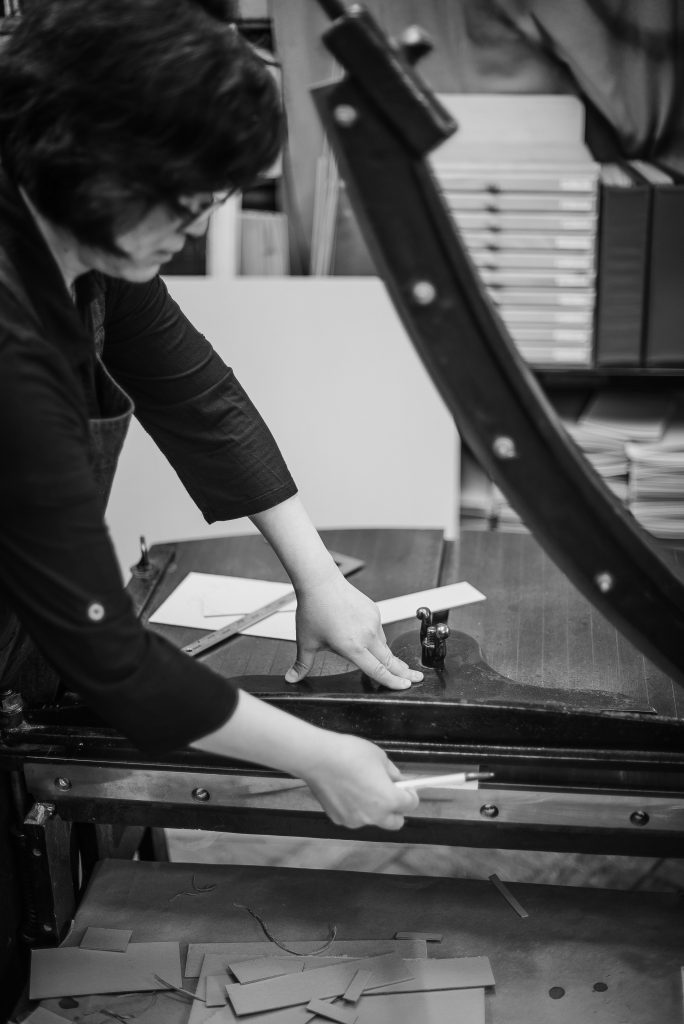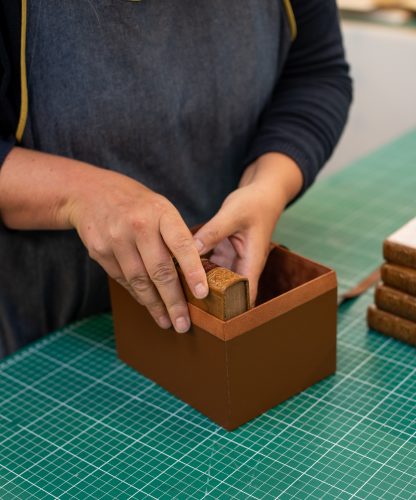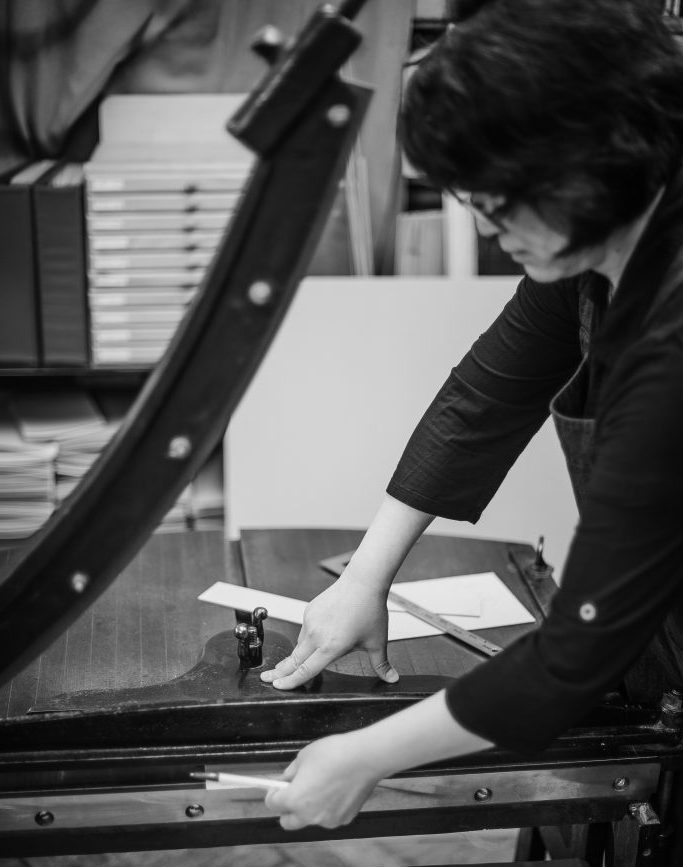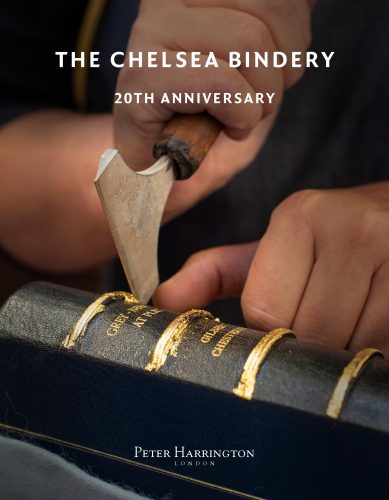Peter Harrington’s in-house bindery, The Chelsea Bindery, is one of only a handful of traditional binderies left in London. To celebrate the 20th anniversary of the bindery’s founding, we’ve put together a catalogue to showcase the beautiful bespoke work carried out by their expert bookbinders.
Bookbinding is a highly skilled craft, taking years to master. Many of the tools, processes, and materials used in traditional binderies have remained largely unaltered for centuries. It requires time, skill, and dedication to train as a master bookbinder, and only a few make this their chosen profession. Ahead of the catalogue’s publication, Lauren Hepburn spoke to Young, who joined the Chelsea Bindery in 2017, about her work as a bookbinder and the day-to-day life of a modern bindery.
Can you tell us a little about your role at the Chelsea Bindery?
I have worked at the bindery for almost three and a half years, mainly making boxes for valuable books. The most popular are the Solander box (also known as a clamshell case or drop-back box) and the slipcase. We customise ours with quality materials (leather or cloth), decorative spine shapes (flat or round; with or without raised bands), finishing (lettering and/or tooling in gold leaf or other colours).
A well-made, airtight box protects a book from getting damaged by oxygen, fire, water, impact, sunlight, temperature, etc. In my opinion, any valuable book should have its own box. Since it keeps the book in good condition, you can also say that its value is safe.
Because housing a book is so important, when you complete a commissioned design binding or submit a competition book, you must also make its own box. Otherwise, it won’t be accepted. Seriously.

Young at work
What led you to this profession?
One day, I was scribbling on a piece of paper absent-mindedly. Then, out of nowhere, a thought crossed my mind: ‘It would be nice to earn a living making bespoke books for people; a book they have always dreamed of. There must be some countries where I can learn the skills…’ As my previous profession had nothing to do with arts and crafts at all, this really was random.
A year later, in 2001, I left South Korea for the UK to make it happen!
How long does it take to learn the skills of the craft?
As long as it takes! I don’t believe that the skills are gained only from time. In my case, I had to keep up my practice every day, both in quality and in quantity. What I can say from my own experience is that the skills become yours sooner than you think when you practise everyday.

A custom slipcase
What does your typical day at the bindery look like?
The first thing I do at work is make myself a strong cup of coffee! I then spend 5-10 minutes sorting out my jobs for the day, then begin working straight away.
What tools and materials do you work with; are they the same as would have been used historically or has technology changed the process?
If it is not for restoration or facsimile binding, I don’t mind working with either historical or modernised tools and materials, as long as whichever I employ produces the best results with the least stress on the books or boxes I’m working on.
Certain traditional equipment and materials are now challenging to get hold of, and bookbinders have inevitably had to search for close substitutes or adopt instruments from other crafts. Some of my tools are even adapted from carpentry and dentistry. In my tool collection I have a dental probe, sickle scaler and tartar scraper, which are handy to clean old glue (usually animal glue) from an aged book spine. In any event, you must always be very careful not to damage the spine.
Bookbinding tools
Nipping presses and standing presses were previously made of cast iron, but these have mostly been replaced by wood or steel. There are very few makers in the world who still use the old kind, The Chelsea Bindery being one of them. I believe our presses are older than I am! Despite their rarity, cast iron presses continue to be preferred among bookbinders because of their solidity and pressure.
Some types of leather are also becoming very difficult to source because of restrictions and ethical issues. For example, exotic leather is strictly controlled in the UK, and France does not trade alum-tawed skin. Also, some ‘60s and ‘70s bookcloths are no longer available, which can be problematic for book repairs and restoration.
Are there any projects you’ve worked on that stood out as particularly special?
One of my private pieces of work, my first ever fine binding, won the 1st prize and Mansfield Medal for the best book in the Designer Bookbinders Competition, in 2003. It is now in the permanent collection of Nature in Art Gallery and Museum, in Gloucester.
Examples of Young’s work
Why do you think traditionally bound books continue to hold such an appeal with people?
Every time I hold a fine binding made using traditional techniques, I just love feeling its firmness and weight in my hands. It is like discovering a rare treasure in perfect shape.
To me, a traditionally bound book is ‘a timeless piece’. I am sure that people who love books see and appreciate this, too.
Roughly how many hours are spent working on each item?
Because every commission is made to order and to the highest standard, it is difficult to attribute a fixed number of hours to our work. No stage in the binding process can be skipped to shorten a lead time. It also usually differs depending on the bookbinders’ skills and experience, the item’s structural details, its materials, size, and so on.
The Chelsea Bindery – 20th Anniversary
Our anniversary catalogue features first, limited, and
special illustrated editions, showcasing the Chelsea Bindery’s mastery of artisanal
techniques, with each binding complementing the book it encases.






